Mesopotamia means “Land between two rivers” and is in the land of Sumer between the Tiger and the Euphrates . It is in this fertile region that agriculture was born. Then the first villages, the first cities, the first city-states and the first empires were born there. Our Mesopotamian ancestors also invented writing, the wheel, commerce, medicine, astronomy, literature, music, the first systems of government and taxation, religion and warfare. They are in direct line our oldest parents...
CIRCA 10,000 BC:Birth of agriculture in Mesopotamia
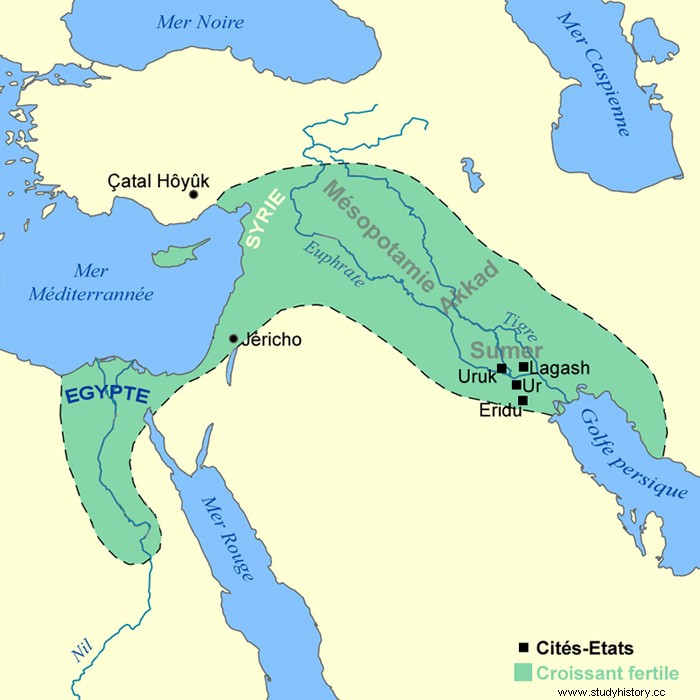
At the beginning of theNeolithic period (About 12,000 years ago), hunter-gatherers had already realized that seeds that fell to the ground germinated and produced plants. But it was only around 10,000 BC that man began to cultivate fields in the “fertile crescent” zone in Mesopotamia . The spring floods of the Tiger and the Euphrates make the region particularly fertile and suitable for agriculture and the populations begin to cultivate wheat and barley. Food production suddenly becomes much faster than hunting and gathering for a much smaller area to exploit. The beginnings of agriculture mark a major turning point in the history of humanity, which we can compare to the industrial revolution.
First villages:
The man begins to build villages to settle near his fields. He tames sheep, goats, then later the ox which is less docile. Thus, it has meat, milk and wool all year round. The invention of domestication and breeding guarantee stable food resources and contribute to the considerable growth of agglomerations and population. The man builds huts for his family and shelters for his cattle which are also used for working the fields. Then the villages multiply, people unite and the villages grow.
CIRCA 8000 BC:First cities and first battles:
Slowly the small villages become towns. One of the oldest finds to date is in Jericho in Mesopotamia.
First battles:
“This is my home!”, “No, this is my home!” . Man is constantly seeking better sources of food, better raw materials, more water, more animals to hunt and domesticate, etc. And as the sedentarization leads to an increase in the population and overexploitation land, men must regularly go in search of more fertile land. Thus broke out the first battles that allowed man to conquer new lands and acquire new wealth.
Social differentiation:
Warriors must defend and protect the invaders' villages and towns and they end up dominating the rest of the population. This is how a hierarchy and social differentiation see the day. This becomes more and more marked as certain men occupy an important place in the community.
CIRCA 6250 BC:Çatalhöyük
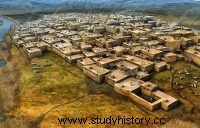 Çatal Höyük in Anatolia becomes a rich city and important with nearly 6,000 inhabitants. The houses are made of raw brick and they are attached to each other. Flat roofs are used to go from one house to another because there are no streets. The walls are covered with paintings, some of which seem to evoke mythical scenes:Vultures attacking headless men, bulls, etc. The dead are sometimes buried under the houses and their skulls deposited in the dwellings.
Çatal Höyük in Anatolia becomes a rich city and important with nearly 6,000 inhabitants. The houses are made of raw brick and they are attached to each other. Flat roofs are used to go from one house to another because there are no streets. The walls are covered with paintings, some of which seem to evoke mythical scenes:Vultures attacking headless men, bulls, etc. The dead are sometimes buried under the houses and their skulls deposited in the dwellings.
CIRCA 5000 TO 3500 BC:Improved agriculture:
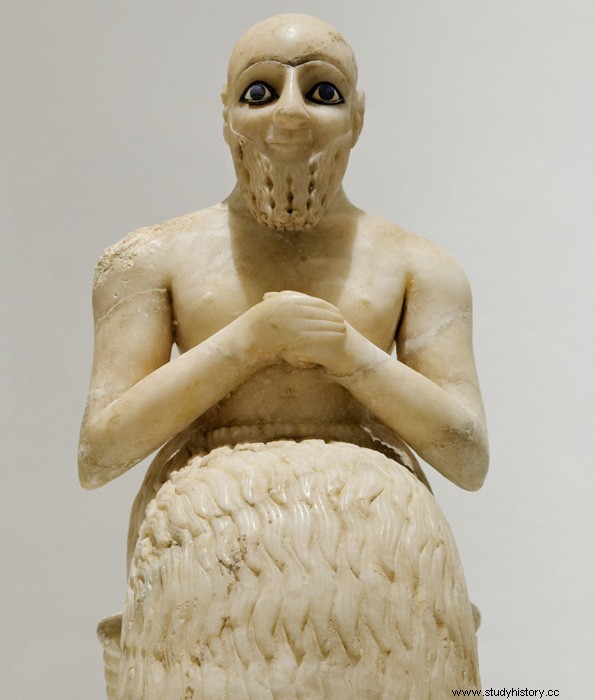
In the area of the Fertile Crescent in Mesopotamia, the floods of the Tiger and the Euphrates are very irregular . They make work particularly difficult and men are forced to invent and build systems of channels bringing water from the rivers to the fields in summer and autumn, preventing the irrigation water from does not stagnate and deposit its salts, and to evacuate the overflow from the spring flood to the reservoirs to avoid drowning the crops. This exhausting work is constantly to be redone but it allows 2 harvests per year and higher yields.
Birth of barter:
In Mesopotamia, men soon harvest more than they consume and it is no longer necessary to mobilize the entire population to work in the fields. Some individuals specialize in other activities like pottery , the weaving , metallurgy , etc. They start to exchange these objects, surpluses of cultivated grain, dates or oil, against hard stones, wood or ores (gold and semi-precious stones) which they do not have in the clay plains of Sumer. This is how the first form of trade was born:barter . As this commercial activity becomes more and more intense, some merchants leave on board small sailboats towards the coasts of the Persian Gulf, as far as the Mediterranean coasts in the west and even as far as the Indus Valley in the east. . To descend the rivers with their heavy cargoes, traders tied together logs to make rafts whose flotation they improved with animal skins inflated with air. Other traders lead donkey caravans across Syria to the Mediterranean coast and some venture east to the Zagros mountain ranges, the largest mountain range in present-day Iraq. /P>
Funeral rites, beliefs and first religions:
The sedentarization being more and more marked, the man attaches a very important place to fertility of the earth. He tries to interpret the world around him and tries to influence it through rituals . More and more beliefs emerge and man begins to venerate the elders, to celebrate the seasons or the cyclic movements of the stars, etc. Thus, he develops mental faculties that allow him to analyze the world and find new rituals. Man gives birth to the first archaic religions and begins to believe that there is a world beyond death.
CIRCA 3500 BC:Semites arrive in Mesopotamia
The Semites arrive from the northwest and settle in the valley of the fertile crescent . They ended up occupying this region from the north to the vicinity of present-day Baghdad. They are called Akkadians because of the name given to the northern part of lower Mesopotamia:Akkad .
Sumerians arrive south of Mesopotamia:
The path that the Sumerians follow to access southern Mesopotamia is less known. Perhaps they came from Central Asia or the Caucasus and descended through Mesopotamia following the Tigris and Euphrates. The myth of the Seven Sages according to the Babylonian priest Berose in 300 BC says that 7 monks would have arrived by the waves of the Persian Gulf and would have taught the inhabitants everything that constitutes “civilized” life:Culture, agriculture, writing , sciences, techniques of founding cities and building temples, etc.
First city-states:
Cities are getting bigger and bigger and turning into city-states . The country of Sumer will eventually have thirty, each attached to its independence. Ur (in present-day Iraq) is one of the oldest and most important.
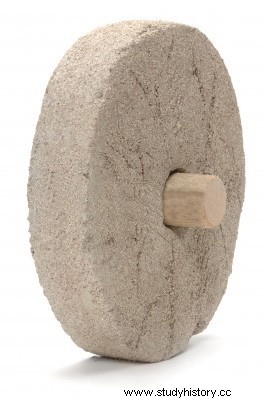
Invention of the wheel:
Men discover that wheels fixed on a trolley allow you to transport goods . An animal pulling a cart carries three times more than on its back! The invention of the wheel represents a crucial technological advancement for our civilization.
Birth of war and royalty:
Thanks to agriculture and trade , the city-states become increasingly rich and attract jealousy from other communities. To protect yourself , men build great stone walls around the city-states. Each city is governed by nobles and when there is war, a leader is chosen to command until the end of hostilities. As Mesopotamia derives extraordinary wealth of its agriculture and its crafts, the wars become increasingly long and frequent . Chiefs sometimes rule their entire lives and pass their power on to their sons. They end up living as absolute masters over the population and the property of their territory, which includes the city, a series of villages and small towns. They become the vicars of the god of the city, but must nevertheless deal with the power of the clergy:it sometimes happens that a priest ousts an heir to power. The rulers of the city-states live off royalties from the population and in return they have the mission of ensuring prosperity. Their ambitions are to impose their suzerainty on the neighboring cities, see all those of the Mesopotamian world that surrounds them. Thus, they are the ones who decide to make peace or war. When they emerge victorious from a battle, they keep local vicars in place and are content with the prestigious title of “kings “. War becomes their favorite artistic theme (See “Stèle des Vautours” below).
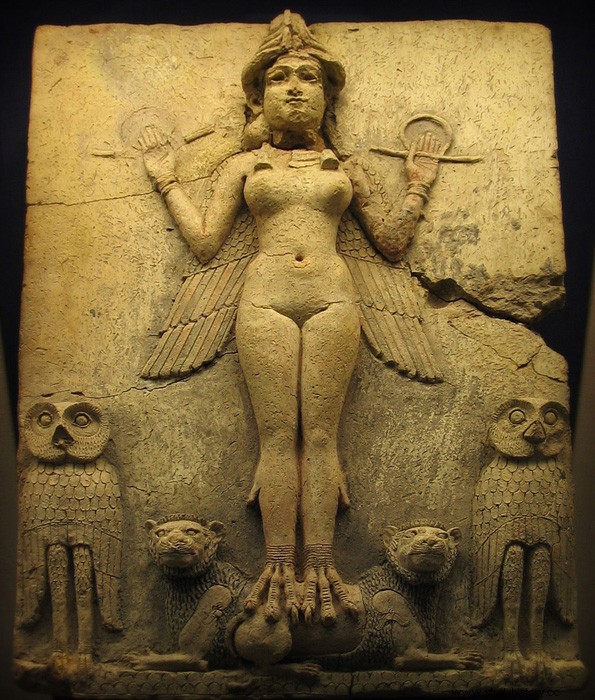
The priests claim that on the day the world was born, a great deity has been assigned to each city-state . These deities, or gods, should be considered the ultimate rulers of the cities. For the population, they are similar to men, eat, drink, love, marry and quarrel. But they are distinguished by their intelligence and eternal life. Each deity is responsible for a function linked to the functioning of the world:For example, Outou-Shamash is the sun-god, Nanna-Sin is the god of the moon, Doumouzi that of the vegetable world and the winds, Ishkour-Adad is the god of storms, seas and rivers, Inanna (future Ishtar) is the winged goddess of vegetation, love and war. It is through priests and priestesses that the gods communicate their desires to men. They must build them temples beautiful, offer them clothes precious, jewelry , music and songs , prepare them rich meals dailies, etc. If the men do not perform the rites, the priests inform them that this risks leading to disasters :floods, drought or raids caused by tribes descending from the mountains. As such calamities are frequent, fear engenders a permanent state of anxiety from which priests and temples profit greatly.
Temples and taxes:
Each city-state has its own temple to which the peasants must offer part of their harvest to avoid the wrath of the gods. Generally speaking, the temple is built on a platform and rises above the dwellings. It is the most grandiose and spectacular building in the city and represents its wealth. The more the city grows rich and develops, the more the temple becomes vast and sumptuous. Large estates were annexed to it, part of which was cultivated by the priests themselves to feed themselves, and to help destitute inhabitants such as widows and orphans.
CIRCA 3300 BC:Invention of writing by pictograms
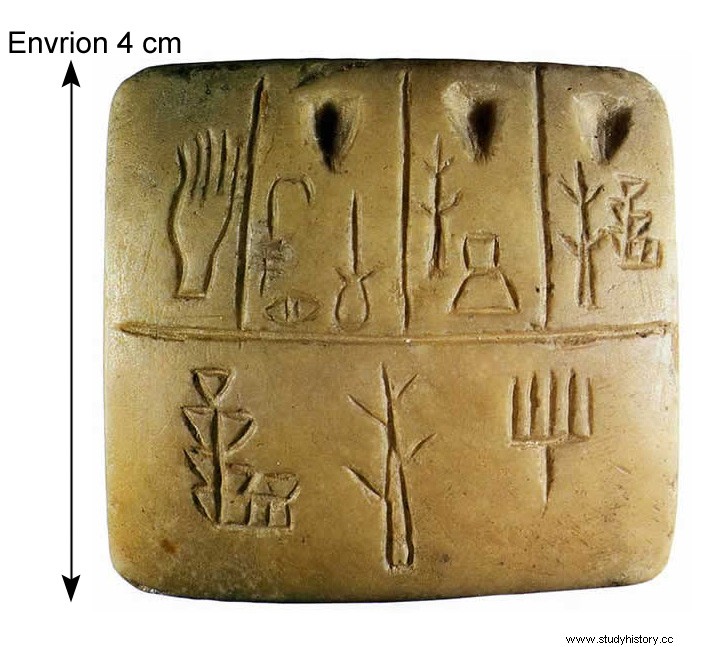
The increase in agricultural production and the development of trade in Mesopotamia forced the Sumerians to keep control on their material environment . This is why the scribes of the city-state of Uruk have developed a system of signs to record the quantities and the nature of the goods. This is initially limited to pictograms engraved on clay tablets, each meaning a word:For example, the star means “sky” and 2 wavy lines mean “water”. Pictograms are also combined to express an idea, hence the term “ideogram”:For example, a mouth drawn next to 2 wavy lines means “drink”.
CIRCA 3100 BC:Invention of phonetic cuneiform writing
Pictograms evolve towards cuneiform writing which means “wedge-shaped”, as the signs are made with reed stems. They no longer designate an object or a word but a syllabic value . Placed end to end, they form a kind of puzzle and allow you to express everything that can be described in spoken language. Writing thus makes it possible to note and recognize goods landed, heads of cattle, sacks of grain, taxes collected, etc. It also allows you to write down your thoughts, to communicate more specifically, to convey advice to a son, to describe myths and stories, to transcribe orders from military leaders, to strengthen the power of the king who can record his own laws, etc. The tablets found on both sides are rich “historical” documents. The most famous is the Epic of Gilgamesh , a king who probably reigned in Uruk around 2650 BC. It was from Uruk that writing spread through Sumerian society and then spread to other regions.
Did you know? The title of the first literary work in the history of mankind is “The Epic of Gilgamesh, the great man who did not want to die”. It is a philosophical and mythological story whose author is unknown and which was written in Sumerian around 1800 BC. Then a second version dating from 1600 BC and engraved in the Akkadian cuneiform language was found in Nineveh and deciphered towards the end of the 19th century. The work had a great influence on Jewish traditions and on the Bible. We also find entire and practically intact passages of the epic of Gilgamesh in the accounts of Greek mythology.
French translation of the story of Gilgamesh by Jean Bottéro:The Epic of Gilgamesh, the great man who did not want to die
Historical comics:Gilgamesh, The Enemy Brothers – Volume 1
The scribes:
The mastery of writing generates a social organization increasingly hierarchical and marked . Initially limited to temples and palaces, it was the prerogative of a closed caste, that of the scribes . They thus become indispensable to the administration of the cities and are the necessary intermediaries between the gods and men.
Writing for the benefit of religion:
dictation tablets by the priests , list the things that the gods prefer and that men must provide:oxen, goats, sheep, pigeons, chickens, ducks, fish, dates, figs, cucumbers, biscuits, etc.
CIRCA 2700 BC:Ur
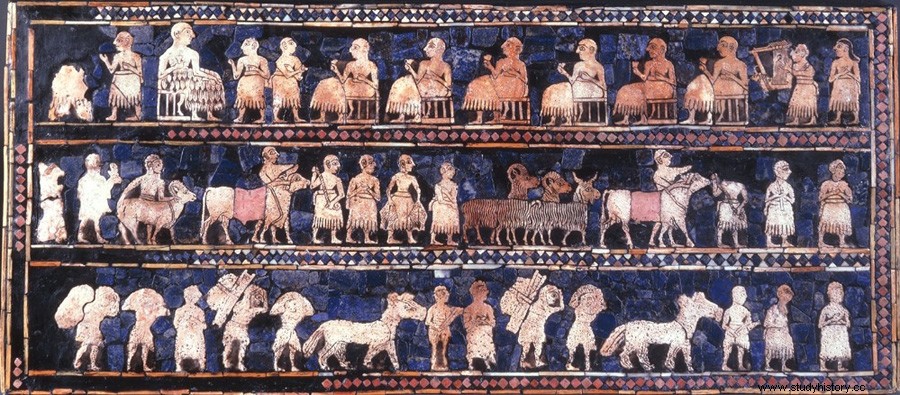
Standard of Ur:
It is a wooden chest which, according to Leonard Woolley, the archaeologist who discovered it around 1920 CE, served as a standard in the city of Ur in Mesopotamia . But it is also possible that it served as a sounding board for a musical instrument. The decor is made of pearly shells, incised and cut, encrusted in a background of colored limestone, all glued with bitumen on wooden plates. The “face of Peace ” probably depicts a banquet scene to celebrate a war victory. The king feasts surrounded by dignitaries dressed in the characteristic Sumerian costume. The servants, “less important” characters, are represented smaller. The “face of war ” is one of the first representations of a Sumerian army engaged in conflict. Soldiers drive a chariot drawn by wild donkeys.
CIRCA 2500 BC:Evolution of religion
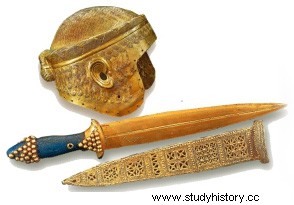
First royal tombs:
The first royal tombs are built so that kings and the queens can be buried there with objects precious as dishes, weapons, headdresses, furniture, jewelry and works of art to accompany them in the afterlife. Their servants , soldiers , guards , companions, harp player are buried at their side after being poisoned .
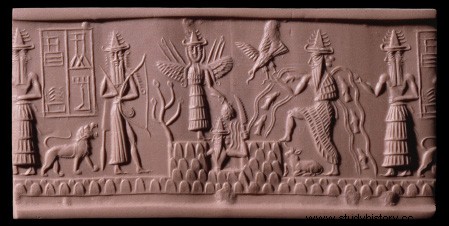
Evolution of religion:
As social differentiation increases, a pantheon single is established above the other divinities. Enlil, the lord of the wind and the god ruler of the Universe , his father An, who no longer wields power but retains its prestige, and Enki, a god with superior intelligence, make up the supreme triad. This ordering of the world will be continued and developed throughout the history of the country, and will largely inspire the neighbors of Mesopotamia and, beyond, to our own civilization. (Photo of a mythological scene:In the center, the sun-god Utu-Shamash appears between 2 mountains. On the right, Inanna-Ishtar has 2 stems growing on her wings and she is holding a bunch of dates. On the left, with Zou, the raptor of storms, the god Enki, ruler of waters and prosperity, has streams of fish springing from his shoulders.)
CIRCA 2450 BC:Stele of the Vultures
This famous stele commemorates the victory of Eannatoum, vicar of the city-state of Lagash, over the 36,000 warriors of the city-state of Umma. It gives an idea of the cruelty clashes :The vicar precedes the troops of soldiers armed with pikes and large square shields, they rush on the opposing army, trample the corpses of the vanquished, pursue their opponents, climb the ramparts and loot the city without sparing the sanctuaries.
CIRCA 2250 TO 2115 BC:Sargon of Akkad conquers the lands of Sumer
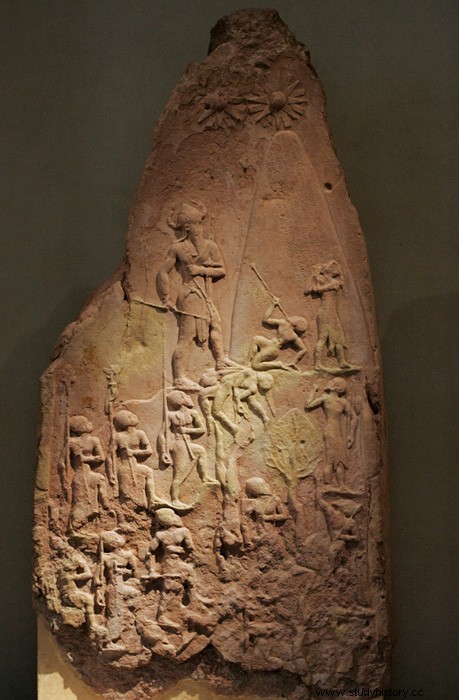
The war is permanent between city-states of Sumer as between those of the Euphrates valley and northern Syria. But the soldier Sargon of Akkad cut short the king's attempts to invade the city of Ummah, and after facing him in 34 battles, he united on his behalf Mesopotamia . He thus created the first Empire of the world, the Akkadian Empire which will last about 135 years. (Photo of the Naram-Sin Stele:This stele represents the height of the dynasty founded by Sargon. The king of Akkad, accompanied by his army, tramples down his enemies whose small size expresses the least importance.)
The legend of Sargon the conqueror:
Sargon would be the son of a nomad and a priestess. His mother not having the right to keep him, he would have been placed in a basket and delivered to the will of the river before being collected by a gardener who would have taken care of him as his own son. One day, Sargon would have been recognized by the goddess Ishtar who would have elevated him to royal dignity. He would then have become the conqueror of the world and the King of the Universe . This story, comparable to that of Moses (a Hebrew), Cyrus (a Persian) or Romulus (a Roman), makes Sargon the ideal hero who saves the world from chaos and becomes its undisputed master. His name itself means "legitimate king", although some Babylonian scribes, by falsifying the signs of cuneiform writing, tried to make him a usurper.
Akkadian Politics:
The rulers of Akkad put in place a policy based on conquest repeated and the military victory . Thus, each triumph brings more power to monarchs and more wealth to the Empire. The large spoils of war are redistributed to the ruling elites and the gods. The term “divine” is associated with the sovereign and social differentiation increases further.
ABOUT 2,115 B.C. J.-C.:The Akkadian Empire weakens and collapses under the invasion of barbarian tribes
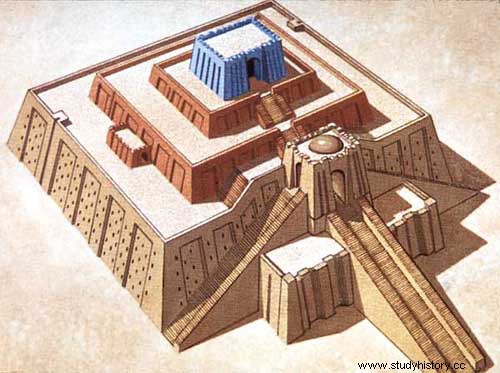
The Goutis , mountain dwellers of Gutium, the Elamites and the nomadic Amorite tribes who came from the desert north-west of Mesopotamia, invaded the lands of Sumer . The last Akkadian king multiplies the defeats soldiers and the Empire collapses . Mesopotamia is again divided and the king of Uruk is the major figure of this time. He hunts the Goutis who are ravaging Sumer.
New empire centered on the city of Ur in Mesopotamia:
King Ur-Nammu of the city of Ur overthrows the power of the king of Uruk who may be his own brother. He founded with his son and successor a new Empire centered on the city of Ur and which is comparable to that of the rulers of Akkad. He had a very large temple built in homage to the moon-god Nanna-Sin. This temple named “Ziggurat ” is pyramidal in shape and includes several floors that manifest the desire of humans to want to access the divine. The staircase is monumental, and like a ladder leading from the earth to the sky, it reflects the will of men to want to rise to the sky. A sanctuary was at the top of the Ziggurat to allow men to be closer to the gods. Sumerian ziggurats are the origin of the myth of the Tower of Babel in the Genesis of the Bible.
AROUND 2040 B.C. J.-C.:Prince Goudéa of Lagash
Goudea is the most famous of the princes of Lagash. The city was at its height during his reign and was the most prosperous of the city-states during this period. The inscriptions engraved on the statues of Goudéa attribute to him only one victory against the Elamites. Goudéa is famous for his pious constructions, in particular for the sanctuary of incomparable splendor that he had built for the tutelary god of his state, Ningirsou. He is also renowned for having inspired religious writings of a very high literary quality, the most beautiful Sumerian texts known, and a high quality plastic art.
AROUND 2003 B.C. J.-C.:The empire of Ur collapses
The invasion of the nomads Amorites , which are breaking on the shores of the Persian Gulf, has become impossible to contain. They invade the lands south of Mesopotamia and Akkad as well as several cities including Babylon . The Elamites put Ur with fire and blood. Betrayed by his family, the last king of Ur, Ibi-Sin, leaves in chains for a distant captivity where he dies.
Mesopotamia is divided again:
A high dignitary of the fallen empire of Ur, Ishbi-Erra , settled in the city of Isin to create the capital there of a new State sovereign. He huns the Elamites and this action secures him first place in the eyes of his contemporaries. The kings of Isin claim the heritage of Ur and Mesopotamia, but they are not the only ones and war is rampant...
